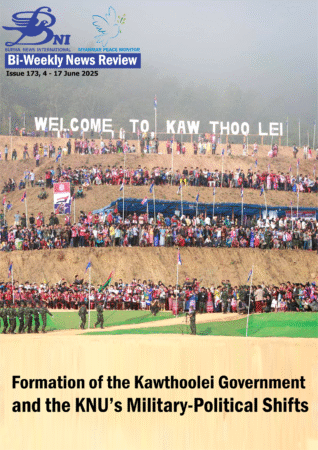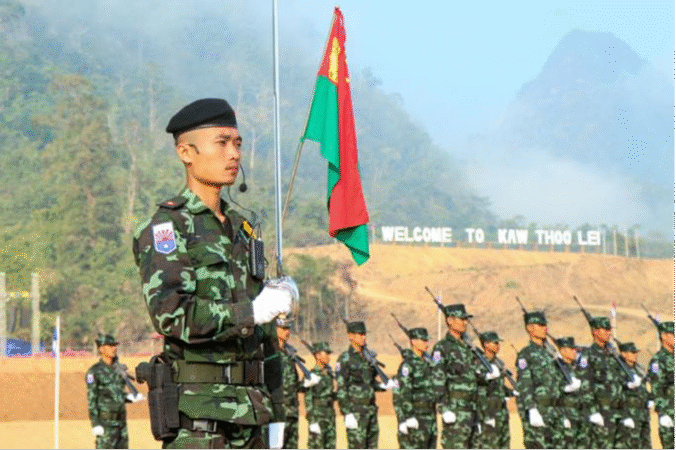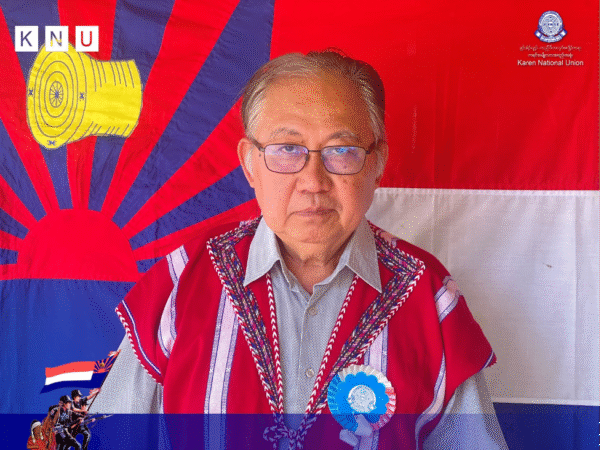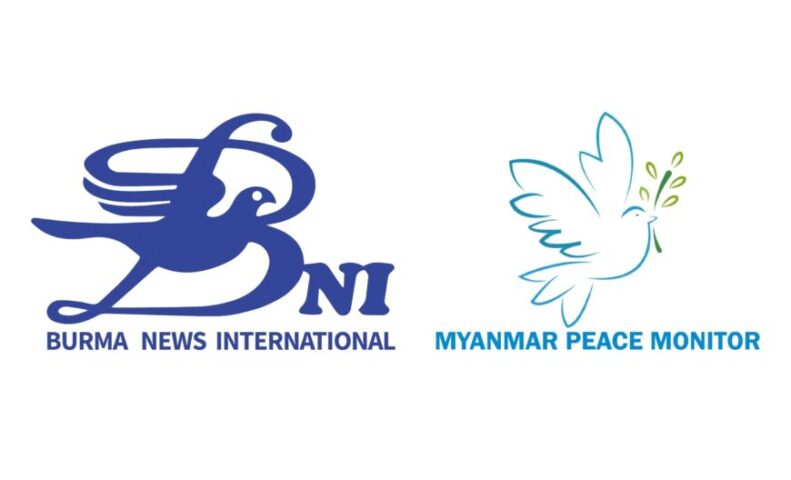
Introduction
The spokesperson for the Karen National Union (KNU) stated that more than 80 percent of the preparations for establishing the Kawthoolei State and its government have been completed. He added that the Kawthoolei government, expected to be officially established by 2025 or early 2026, will function as a constituent state in a future federal democratic union.
This week, Burma News International (BNI)-Myanmar Peace Monitor (MPM)’s Bi-Weekly News Review focuses on the Kawthoolei State, the formation of the Kawthoolei government, the KNU’s military and political developments, and regional challenges.

The Kawthoolei Process
The Kawthoolei State is set to be established under the soon-to-be-ratified Kawthoolei Treaty. As part of its governance structure, a Kawthoolei Consultative Council (KCC) — modeled after a parliamentary system — will be formed. The KCC will hold legislative authority and will comprise five main blocs: KNU district-level representatives, non-Karen ethnic groups, elected representatives from the 2020 election within the Kawthoolei territory, as well as youth and women’s groups from the region.
Through this, the KCC will have a Kawthoolei Executive Committee (KEC) responsible for overseeing administrative affairs. The KEC will handle administrative tasks and the formation of ministries. Through this structure, the Kawthoolei Government (KG) will be formed. Since the KG is being established during the revolutionary period, the KNU will continue to be involved in leadership, guidance, and supervisory roles. However, as it will be organized in a KNU Plus (+) model, the groups mentioned earlier will also participate, as explained by KNU spokesperson Padoh Saw Taw Nee. 1
The political objectives—such as the attainment of equal rights and full self-determination, the establishment of a just and inclusive Kawthoolei (Karen State), the creation of a democratic federal union based on self-determining states, and the guarantee of full democratic rights for all Karen people and all citizens within the Union—are fundamental principles that the Karen National Union (KNU) has consistently upheld. When the future federal democratic union is established, the Kawthoolei State and Kawthoolei Government will fully participate as a member state of the Union, said Padoh Saw Taw Nee.
Kawthoolei Shift or KNU’s Military and Political Shifts
The concepts of the Kawthoolei State and its government are not new; they have existed for more than 76 years. The concepts of the Kawthoolei State and its government are not new. They have existed for more than 76 years. When the Karen National Union (KNU) launched its armed struggle and began capturing towns and villages around 1949–1950, the need arose to establish systems for administration and governance of public affairs. Therefore, on 14 June 1949, an emergency meeting was convened in Taungoo town to establish the Kawthoolei government and set up administrative plans. At the first Kawthoolei Governance Body (KGB) meeting held in April 1950, 14 June was officially designated and honored as Kawthoolei Day, commemorating the founding of the Kawthoolei Government.

14 June 2025 marks the 76th anniversary of the establishment of Kawthoolei state and the formation of the Kawthoolei government. The current chairman of the Karen National Union (KNU), Padoh Saw Kwe Htoo Win, said that through Kawthoolei Day, which is connected to the Karen people’s revolutionary history, they have gained two important lessons: political guidance and the art of public administration. In the current era of efforts to build a federal democratic union, the administration and public affairs management will be established in the areas controlled by the KNU. 2
On 31 January 2024, the Chin National Front (CNF), Karenni National Progressive Party (KNPP), and the National Unity Government (NUG)—all actively fighting against the military dictatorship—jointly announced a common stance in support of ending the military dictatorship and establishing a federal democratic union.
The statement outlines six political objectives: to remove the military dictatorship and end the Myanmar military’s role in politics; to place all armed groups fully under the administration of a democratically elected civilian government; to completely abolish the 2008 constitution and eliminate any efforts to revive it; to draft a new constitution based on a federal and democratic system acceptable to all parties; to establish a new federal democratic union according to this constitution; and to ensure justice for victims of conflict-related injustices through transitional justice processes.
Additionally, in building the future federal democratic union through a bottom-up federalism approach—from strong states to a strong union—the KNU has also participated in the joint statement issued by nine groups, including Ethnic Resistance Organizations (EROs) and federal councils representing states and ethnic groups.
Since the military coup, the KNU has supported civil servants involved in the Civil Disobedience Movement (CDM) and stood with the Spring Revolution against the military takeover, actively collaborating within the National Unity Consultative Council (NUCC). Due to intense offensives by the junta forces in the KNU-controlled areas, the KNU has been collaborating with resistance allied groups, including People’s Defense Forces/ Local Defense Forces (PDFs/LDFs), to lead and actively participate in the armed resistance of the Spring Revolution.
The KNU plays a leading role in the Central Command and Coordination Committee (C3C), which is jointly formed by the NUG Ministry of Defense and four allied EROs. In the southern military region, the KNU actively participates alongside the KNPP and the NUG in the Joint Coordination Committee (J2C) and the Joint Operations Command (JOC), providing leadership in their collaborative efforts.
The Capture of Towns/Bases and Regional Challenges
Since early December 2023, the KNU and allied local forces have successfully captured and held control of the towns of Mone, Kyikdo, Hpapun, and Lay Kay Kaw from the military junta, as well as approximately one hundred junta military camps.
The KNU’s military momentum has accelerated to the point that they have even reached a position to seize and control Myawaddy—a town critically important not only for military and political, border reasons but also for cross-border trade.
According to BNI-MPM data, since the coup, clashes between the KNU and allied local forces and the junta troops have occurred in over 30 townships across Karen State, Bago (East) Region, Mon State, and Tanintharyi Region, including areas within the Nay Pyi Taw Council Territory. Myawaddy, Kawkareik, Hpapun, and Kyainseikgyi Townships in Karen State have experienced the most intense fighting, while Kyaukkyi and Nyaunglebin Townships in eastern Bago, were hotspots of severe clashes. Additionally, Bilin and Kyaikto Townships in Mon State have seen heavy fighting, and, Tanintharyi and Dawei Townships in Tanintharyi Region have been among the areas with intense conflict. 3
The vigorous military movements of the KNU and its allied local armed groups have faced limitations and challenges due to the activities of local Karen armed groups that did not participate in the Spring Revolution, as well as the Border Guard Force (BGF) under the military junta’s control. This is especially evident when observing the battle for the control of Myawaddy town. This is especially evident in the capture of Myawaddy town. 4
The participation and cooperation of local groups in events like the capture of Myawaddy town provide crucial lessons for the Karen National Union (KNU) in its effort to establish the Kawthoolei State and Government. However, this also poses significant challenges that must be carefully navigated and overcome.
Review
The KNU, established on 5 February 1947, is the oldest and most experienced ERO in the country. It has stood alongside the people in opposing outdated and oppressive regimes throughout its history.
Moreover, throughout the history of the Karen revolution—which has consistently pursued equality, justice, autonomy, and self-determination—the KNU has employed a range of approaches, including military action, political strategies, and peace talks. At the same time, it is also familiar with the military regime’s methods of division, intimidation, deception, and military pressure.
Nevertheless, in the Kawthoolei area (Karen State), the role of the non-affiliated armed resistance groups under the leadership and alliance of the KNU remains a crucial process to be carefully approached for the establishment of Kawthoolei and its government. At the same time, the activities of the junta-backed Border Guard Force (BGF) in Karen State also require careful attention.
It remains to be seen whether the KNU’s step and direction—reported to be over 80% complete toward establishing the Kawthoolei State and government—will mark a new and historic milestone in the history of the Karen revolution.
1 Karen National Union (KNU) Spokesperson P’doh Saw Taw Nee’s statement on Kawthoolei Day and shares insight about Kawthoolei Federal Unit, 14 June 2025
2 Speech by KNU Chairman Padoh Saw Kwe Htoo Win on 76th Anniversary of Kawthoolei Day, 14 June 2025
3 Myanmar Armed Conflict Dashboard (Jan 2020 – 17 Jun 2025), BNI-MPM
4 Myawaddy conundrum, Bi-Weekly News Review – Issue 143, BNI-MPM, April 2024
